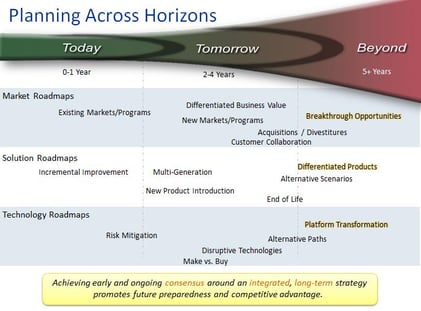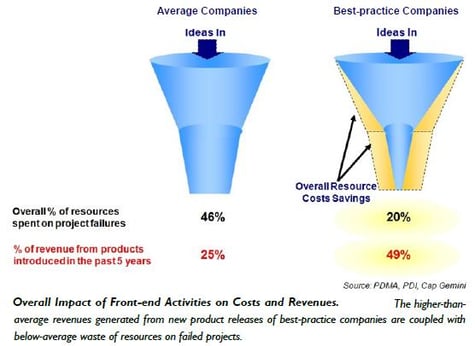In my last post, I discussed the history of PDM and PLM up to the present. In this post, I discuss the great opportunities that await most large organizations that chose to take up the business value optimization challenge.
Planning Across Horizons
With Stage-Gate ® (or any gated-process) in place, gaps still remain in achieving strategic long term innovation. How do you incorporate innovation into your strategic planning process? How do you align your high level business aspirations, medium to long term in nature? How do you link your growth objectives or market assessment to your innovation pipeline all the way through products, services, and solutions, down into technologies, and align everything (i.e. new markets, regulatory, compliance, etc.) to your overarching growth goals?
Innovation must go beyond automating the structured decision-making and resource prioritization focusing on which product development initiatives get funded and which do not. In short, innovation must go well beyond the current operating plan and year, well into the market future five to twenty-five years out.
This type of innovation requires collaborative long-term strategic planning at the corporate, business unit and operational levels of a company. Annual operating plans must be augmented with collaborative cross-functional tools that incorporate long-term market trends and map them to define emerging market needs. While strategic roadmapping tools have been around a few years, they are typically visual and not linked to ROI data, capacity management or product definition, and do not adequately reflect external business drivers.
The goal is to create integrated roadmaps that achieve early and ongoing consensus and future preparedness for breakthrough opportunities, differentiated products and disruptive technologies for competitive advantage. Fundamentally, database driven roadmaps provide visibility of strategic options for long-term opportunities connected to market and technology investments.

Filling in the Gaps—Feeding a High-Value Funnel with Good Ideas
According to the PDMA, Product Development Institute and Cap Gemini, as many as 79% of companies admit to a lack of high-value projects in their portfolio resulting from not having enough high-value ideas entering their pipeline. Additionally, companies not in their best-practice groups spent more than twice as much on unsuccessful products with wider funnels of ideas that weren't prioritized nor implemented to backfill key gaps in current or future development projects. Idea management fills this void between strategic planning and execution with highly qualified idea campaigns targeted to specific groups most qualified to support them.
. 
The New Frontier in Business Value Optimization and Innovation Performance: “One-of-a-Kind” Ability to Optimize Portfolios Across Multiple Constraints
With strategic planning, idea management and process execution tools in place, new product introduction in context with its portfolio value can now be optimized. Optimization beyond the standard reports and bubble charts normally associated with portfolio management is now possible. Imagine the ability to identify “optimal” scenarios within a complex set of portfolio data – scenarios maximizing value (e.g. “NPV”) within one or more resource constraints (e.g. both capital and human resources). Consider scenarios that will suggest the optimal portfolio by removing lower value initiatives to achieve maximum NPV within capital and resource constraints.
The future is now and portfolio optimization provides a new wave of enormous opportunity for business value optimization. Opportunity supporting prioritized recommendations based on historic resources and inherited portfolio values that easily roll-up band, region, and BU level to easily identify business needs and gaps are now possible. Additionally, scoring and managing multiple programs/project resources, resource demands, capacities, demand curves and resource pools using “what if” scenarios offer powerful new innovation investment opportunities throughout the annual operating plan and iterations thereafter.




